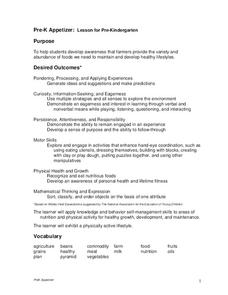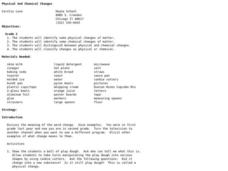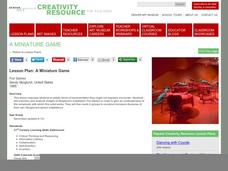Curated OER
What Shape is That?
Each country or group of people has created special places of worship. Children read a story about religious buildings and architecture and then make clay models of the buildings they like the best. The lesson has been written to...
August House
Anansi And Turtle Go To Dinner
That tricky Anansi! Join him and Turtle in the story Anansi and Turtle Go to Dinner by Bobby and Sherry Norfolk, based on the African folktale. Kids answer comprehension questions and sing songs about spiders before creating spider...
Curated OER
Pre-K Appetizer
Students understand there are healthy and not healthy food choices. In this food pyramid lesson, students learn to make healthy choices by playing a traffic light game. Students recognize raw foods from the farm may not be ready for...
Curated OER
Animal Habitats
Students explore animal lifestyles by researching their characteristics. In this animal habitat lesson plan, students read the story Over in the Jungle and analyze the animal illustrations in the book. Students create clay animal...
Curated OER
Adding Adaptations to Insects
Fourth graders investigate elements of physical adaptation in insects and organisms. They discover how adaptations can select an insect for survival and make an insect that be used in an outdoor discovery activity.
Curated OER
Where are all those teeth?
Students explore the legend of the tooth fairy. They create a tooth necklace out of dough and glitter.
Curated OER
T Letter Ideas
Students participate in activities that begin with the letter "T". They also expand their vocabulary.
Curated OER
PLATE TECTONICS WITH AN ORANGE
Students explore the concept of plate tectonics. They experiment to prove and explain plate tectonics.
Curated OER
What's Crackin' Under New Zealand
Students construct a model of the Earth using clay and oranges. In this earth science lesson, students explain the causes of earthquakes and volcanic activity. They write their findings in their science journal.
Curated OER
PBS Kids Go Buster Buster and Beatrice/ The Giant Pumpkins
Second graders visit San Antonio, Texas and Mt. Hood, Oregon in these two episodes of PBS Buster Go Kids. They examine the music and food that is local to San Antonio by looking at images and pretend to play instruments. They use...
Curated OER
Water and Ice
Students conduct an experiment. In this forms of water lesson, students observe ice to see what changes take place and then write in their journal about what they observed.
Curated OER
Stem Cell Development
Like a fresh canvas, stem cells can turn into almost anything. In a comprehensive lesson, high school biologists use clay to build a 3-D model of cell division and the processes that occur during the first 14 days of development. Also...
Cornell University
Beam Focusing Using Lenses
Explore optics using an inquiry-based experimental approach! Young scholars use a set of materials to design and build a unit capable of focusing a beam of light. They experiment with different lenses to determine the best approach to...
Curated OER
Understanding Lava Layers
Seventh graders view "Volcano" by National Geographic Video. They experiment with baking soda and study lava flow. They describe volcano and earthquake patterns. They analyze weather and climate changes and how they relate to the natural...
Curated OER
Aerosol Lesson: Language Arts
Pupils construct a model of a volcano. They read "NASA Facts Atmospheric Aerosols" and discuss the impacts of volcanic eruptions. They write informative essays about how aerosols impact the Earth.
Curated OER
A Feature Presentation - Geographic Landforms
Students investigate, identify and compare the various geographic terms that can be used to describe the landforms occurring in the Hawaiian islands.
Curated OER
Making a Thermometer
Young scholars observe a demonstration of how a thermometer functions. They apply the scientific method while determining which of three cups hold the coldest water. They write a hypothesis before conducting the experiment and gather data.
Curated OER
Minerals Make Rocks
Students examine that all rocks are made from one or more minerals (or plant material, as in the case of coal). They make mock rocks and discuss the difference between a rock and a mineral.
Curated OER
Physical And Chemical Changes
Second graders identify physical and chemical changes of matter. They distinguish between physical and chemical changes. They classify changes as physical or chemical.
Curated OER
Build a 3-d Plant Model
Third graders construct a three-dimensional model of a flowering plant. They examine the major plant parts and their basic functions. They demonstrate an understanding of the similarities and differences in the physical...
Curated OER
World Continents
Students identify the continents of the world. In groups, students create a three-dimensional clay representation of their assigned continent. Using KidPix software, they draw and color their continent. Students research their continent...
Curated OER
Making Prehistory
Students create mock fossil records based on current scientific theories about prehistory. By learning about what fossil records teach us about different prehistoric time periods, students gain a greater understanding of theories of...
Curated OER
What's in the Sock?
Second graders use their sense of touch to identify a variety of objects. In this sense of touch lesson, 2nd graders listen to a read aloud of Sandra Boynyon's, Fuzzy Fuzzy, Fuzzy. They talk about different textures and about the...
Curated OER
Lesson Plan: A Miniature Game
Art inspires art, as children work to understand artistic forms that come from the imagination. They analyze the installation piece, Fox Games and then discuss the design process. They then use clay to create imaginative dioramas,...

























